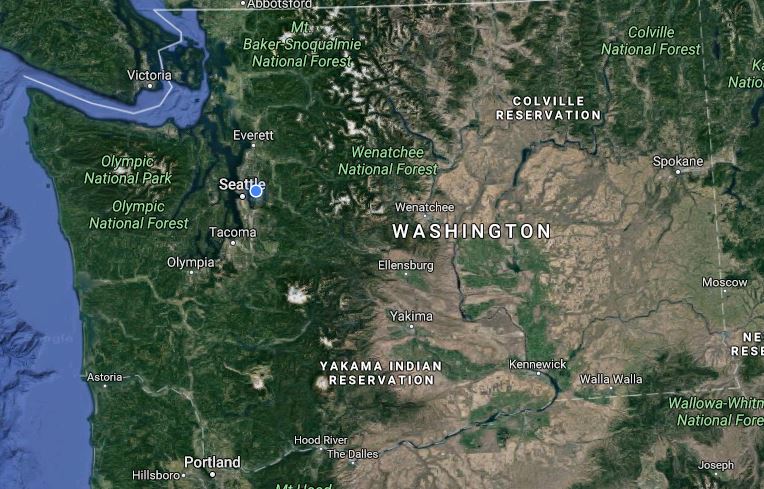Eastern Washington is Very Dry
When most people think about the state of Washington, thick forests and abundant rainfall come to mind. Guess what? For the bulk of the state, this is not the case. Check out the photo to the right: there’s a whole lot of brown – dry desert – in the Washington landscape.

Over one-third of the land in the state is considered semi-arid cold desert, dominated by shrub-steppe prairie. Sagebrush, cactus, and the Western rattlesnake all find Washington a delightful place to call home. This dry scrubby landscape is found on the east side of the Cascade Mountain Range; much of the remainder of Eastern Washington is a ponderosa ecosystem, dominated by sparse pine forests and dry grasslands.
The annual rainfall map below illustrates the great variation in climate across Washington State. Locations with as much or more rain as Seattle are shown with blue circles; locations drier than Seattle are shades of orange.
The Rain Shadow Effect
A rain shadow is a dry area on the downwind side of a mountain range. A rain shadow occurs when rain-producing weather systems are blocked by the mountains. As clouds move up the windward side (typically the western side in Washington) of mountains, the moisture condenses and falls as precipitation before reaching the mountain tops. The weather system continues on to the other side of the mountain range with significantly less moisture, allowing communities on the east side of Washington mountains to enjoy many more dry sunny days than those on the western side of the mountains.
The rain shadow effect is a powerful factor in Washington, where mountain ranges – including the Olympics, the Cascades, and the Blue Mountains – dominate the landscape. As you can see in the above data map, when it comes to precipitation and cloud cover, where you sit in relation to a mountain range determines how much you’ll experience.
The Wet Parts of Washington State are Really Wet
While the bulk of Washington is not extraordinarily rainy, there are some sections that are super wet. Not surprisingly, these are on the west side of the Olympic and Cascade Mountains, where you’ll find the temperate rain forests that are iconic of the state. These lush green forests can be found on the west sides of the Olympic and Cascades mountain ranges.
The Olympic Peninsula, less then 100 miles wide, provides an excellent example of the power of the rain shadow effect. Take a look at the chart below. While the windward side of the Olympic Mountain Range experiences the type of rainfall people associate with Washington State (if not more), the towns of Port Angeles and Sequim benefit from being in the rain shadow, enjoying the relatively dry sunny climate that makes these places popular with retirees and tourists.
Putting Washington Rainfall in Context
So now we can see how the precipitation varies across the state of Washington. How does it all compare to other US cities? It’s still quite wet compared to those, right? No – check out the chart below. Major cities like Miami, Houston, and NYC all get considerably more annual rainfall than Seattle.
